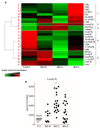5-oxoETE triggers nociception in constipation-predominant irritable bowel syndrome through MAS-related G protein-coupled receptor D
- PMID: 30563864
- PMCID: PMC6411128
- DOI: 10.1126/scisignal.aal2171
5-oxoETE triggers nociception in constipation-predominant irritable bowel syndrome through MAS-related G protein-coupled receptor D
Abstract
Irritable bowel syndrome (IBS) is a common gastrointestinal disorder that is characterized by chronic abdominal pain concurrent with altered bowel habit. Polyunsaturated fatty acid (PUFA) metabolites are increased in abundance in IBS and are implicated in the alteration of sensation to mechanical stimuli, which is defined as visceral hypersensitivity. We sought to quantify PUFA metabolites in patients with IBS and evaluate their role in pain. Quantification of PUFA metabolites by mass spectrometry in colonic biopsies showed an increased abundance of 5-oxoeicosatetraenoic acid (5-oxoETE) only in biopsies taken from patients with IBS with predominant constipation (IBS-C). Local administration of 5-oxoETE to mice induced somatic and visceral hypersensitivity to mechanical stimuli without causing tissue inflammation. We found that 5-oxoETE directly acted on both human and mouse sensory neurons as shown by lumbar splanchnic nerve recordings and Ca2+ imaging of dorsal root ganglion (DRG) neurons. We showed that 5-oxoETE selectively stimulated nonpeptidergic, isolectin B4 (IB4)-positive DRG neurons through a phospholipase C (PLC)- and pertussis toxin-dependent mechanism, suggesting that the effect was mediated by a G protein-coupled receptor (GPCR). The MAS-related GPCR D (Mrgprd) was found in mouse colonic DRG afferents and was identified as being implicated in the noxious effects of 5-oxoETE. Together, these data suggest that 5-oxoETE, a potential biomarker of IBS-C, induces somatic and visceral hyperalgesia without inflammation in an Mrgprd-dependent manner. Thus, 5-oxoETE may play a pivotal role in the abdominal pain associated with IBS-C.
Copyright © 2018 The Authors, some rights reserved; exclusive licensee American Association for the Advancement of Science. No claim to original U.S. Government Works.
Conflict of interest statement
Figures






References
-
- Mearin F, Lacy BE, Chang L, Chey WD, Lembo AJ, Simren M, Spiller R. Bowel Disorders. Gastroenterology. 2016 - PubMed
-
- Ohman L, Simren M. Pathogenesis of IBS: role of inflammation, immunity and neuroimmune interactions. Nat Rev Gastroenterol Hepatol. 2010;7:163–173. - PubMed
-
- Cenac N, Bautzova T, Le Faouder P, Veldhuis NA, Poole DP, Rolland C, Bertrand J, Liedtke W, Dubourdeau M, Bertrand-Michel J, Zecchi L, et al. Quantification and Potential Functions of Endogenous Agonists of Transient Receptor Potential Channels in Patients With Irritable Bowel Syndrome. Gastroenterology. 2015;149:433–444 e437. - PubMed
-
- Barbara G, Wang B, Stanghellini V, De G R, Cremon C, Di N G, Trevisani M, Campi B, Geppetti P, Tonini M, Bunnett NW, et al. Mast cell-dependent excitation of visceral-nociceptive sensory neurons in irritable bowel syndrome. Gastroenterology. 2007;132:26–37. - PubMed
Publication types
MeSH terms
Substances
Grants and funding
LinkOut - more resources
Full Text Sources
Other Literature Sources
Molecular Biology Databases
Miscellaneous

